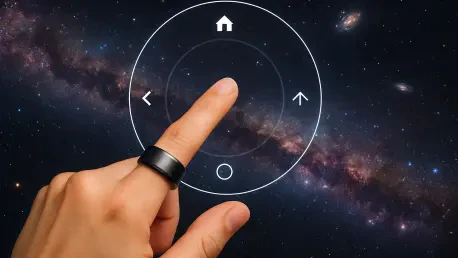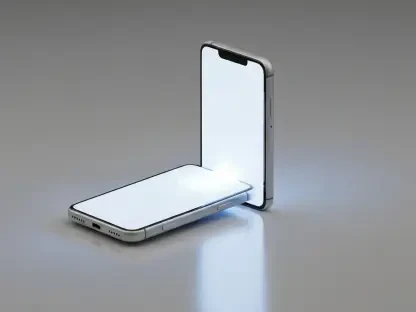What if a small device on your finger could transform the way virtual worlds are explored, making clunky controllers a relic of the past? In 2025, Samsung is pushing the boundaries of wearable technology with the Galaxy Ring, a device that promises to redefine navigation in extended reality (XR) environments. This tiny gadget, initially designed for fitness tracking, is now poised to become a game-changer in how users interact with mixed-reality spaces through intuitive gesture controls. The implications of this innovation are vast, potentially reshaping the landscape of digital interaction.
The Rising Need for Seamless XR Control
As XR technology gains traction in gaming, education, and professional training, the demand for natural, immersive control methods has surged. Traditional handheld controllers often disrupt the flow of virtual experiences, leaving users frustrated with awkward mechanics. Samsung’s exploration into gesture-based navigation with the Galaxy Ring addresses this gap, aiming to create a bridge between physical movements and digital responses. This shift could make XR more accessible to a broader audience, eliminating the learning curve associated with complex hardware.
The significance of this development lies in its potential to integrate seamlessly into daily life. With wearable tech already playing a key role in health monitoring and communication, expanding its purpose to XR navigation feels like a logical next step. If successful, this innovation could set a new benchmark for user interfaces, making virtual environments as intuitive as interacting with the real world.
Breaking Down the Galaxy Ring’s Cutting-Edge Features
Samsung is not holding back in its ambition to transform the Galaxy Ring into a versatile controller for XR headsets. A recent Android app update, spotted by industry insiders, revealed code referencing “ring gesture for glasses,” hinting at the ability to navigate XR interfaces with simple hand motions. This suggests a future where a flick or pinch could scroll through menus or select options in a virtual space, offering a hands-free experience that feels effortless.
Beyond gesture control, Samsung’s vision extends to multi-screen compatibility. A patent uncovered earlier in 2025 detailed plans for the ring to interact with various devices, from smart TVs to tablets, positioning it as a universal tool. This approach aligns with Samsung’s broader goal of creating a connected ecosystem where users can transition smoothly between devices without changing their mode of interaction. Such advancements indicate a leap toward more cohesive digital experiences.
The focus on enhancing user experience is evident in the shift from basic functions, like silencing alarms with a double-pinch, to sophisticated navigation capabilities. This evolution reflects an understanding of the need for fluidity in XR environments. If these features come to fruition, they could mirror natural human gestures, making interactions in virtual spaces feel instinctive and less mechanical.
What the Tech World Is Saying
The buzz surrounding Samsung’s direction with the Galaxy Ring is palpable within the tech community. A notable industry analyst remarked, “Should Samsung master gesture navigation with this wearable, it could redefine standards for XR interaction across the board.” This sentiment echoes a growing excitement for hands-free technology, with many seeing wearables as the future of user interfaces in an increasingly digital world.
Feedback from early adopters of the Galaxy Ring also fuels optimism. Many users express a desire for expanded functionality beyond fitness tracking, indicating a ready market for XR navigation features. While specifics remain under wraps, the consensus points to Samsung tapping into a broader trend toward intuitive design. This alignment with user expectations could position the company as a leader in merging physical and digital interactions.
Analysts also note that Samsung’s efforts reflect a strategic push to stay ahead in the competitive wearable market. With other tech giants exploring similar innovations, the race to perfect gesture control is heating up. The anticipation around Samsung’s next moves suggests that the industry is watching closely, eager to see how this technology unfolds in practical applications.
How Gesture Navigation Might Transform Your XR Experience
Picture navigating a virtual landscape with nothing more than a subtle hand movement, free from the constraints of traditional controllers. If Samsung’s vision materializes, pairing the Galaxy Ring with an XR headset could be as simple as syncing it through a dedicated app within the company’s ecosystem. This streamlined setup ensures that even those new to XR can dive in without hassle, democratizing access to advanced tech.
Customization is another key aspect of this potential feature. Users might map specific gestures—like a wave to return to a home screen or a pinch to confirm selections—through a companion app, tailoring controls to personal preferences. Additionally, practicing these motions in a virtual tutorial space could refine accuracy, ensuring smooth operation during real-world use. This adaptability caters to both beginners and seasoned XR enthusiasts, enhancing precision across skill levels.
The broader implications include extending these gestures to other devices, such as smart home systems or mobile screens, if Samsung’s multi-screen patent becomes reality. This versatility could create a unified control method across a user’s tech lineup, reducing the need to switch between different interfaces. Such integration promises a future where digital navigation feels as natural as pointing or waving in everyday life.
Challenges and Expectations on the Horizon
Despite the excitement, hurdles remain in perfecting gesture navigation for XR. Ensuring precision in detecting hand movements, especially in varied lighting or crowded environments, poses a technical challenge. Samsung will need to refine sensor accuracy to prevent misreads that could disrupt user immersion, a concern raised by some tech observers monitoring these developments.
Battery life is another factor to consider, as continuous gesture tracking could strain the Galaxy Ring’s power capacity. Balancing functionality with endurance will be crucial to avoid frequent recharging, which might deter users seeking all-day usability. Addressing these practical issues will determine how effectively this innovation integrates into daily routines.
Moreover, the timeline for widespread adoption remains uncertain, with speculation around a next-generation Galaxy Ring possibly launching between 2025 and 2027. While the wait may test patience, the focus on overcoming these obstacles suggests a commitment to delivering a polished product. The tech community remains hopeful that Samsung will prioritize quality over speed, ensuring a reliable experience when the feature rolls out.
Reflecting on a Bold Step Forward
Looking back, Samsung’s journey with the Galaxy Ring marked a pivotal moment in wearable technology, blending everyday utility with the promise of futuristic XR navigation. The strides made in gesture control sparked a wave of anticipation, hinting at a world where virtual interactions mirrored real-life ease. Each development, from app updates to patents, built a foundation for a transformative user experience.
As this innovation unfolds, the next steps rest on refining technical precision and addressing practical limitations like battery life. For users and industry watchers alike, staying informed about Samsung’s progress is essential, with each update offering a glimpse into the evolving landscape of XR. The potential to reshape digital engagement lingers as a powerful motivator, urging continued exploration of hands-free tech.
Beyond immediate challenges, the broader consideration is how such advancements could inspire other sectors, from education to healthcare, to adopt immersive tools. The legacy of this endeavor points toward a future where technology feels less like a barrier and more like an extension of human capability. Keeping an eye on Samsung’s roadmap offers a chance to witness, and perhaps participate in, the next wave of digital evolution.









